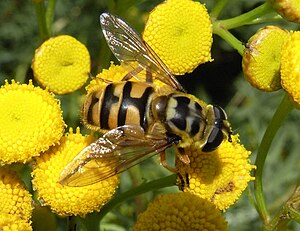Skull hover fly
| Skull hover fly | ||||||||||||
|---|---|---|---|---|---|---|---|---|---|---|---|---|

Skull Hover Fly ( Myathropa florea ) |
||||||||||||
| Systematics | ||||||||||||
|
||||||||||||
| Scientific name | ||||||||||||
| Myathropa florea | ||||||||||||
| ( Linnaeus , 1758) |
The skull hover fly , more rarely also called the common umbel hover fly , ( Myathropa florea ) is a species from the family of the hover flies (Syrphidae).
features
The flies reach a body length of 12 to 14 millimeters. Her face has a black central welt, the antennae are black. The females have a black forehead, with the sides dusted yellow. On the mesonotum there is a yellow-black pattern that resembles a skull and makes the species unmistakable. The species owes its German name to this drawing. The abdomen is black and has large yellow spots on the sides of the segments. The wings are tinted light brown. The legs are drawn yellow and black, the tarsi are predominantly black.
Occurrence
The species is distributed in Europe and east to Siberia and Central Asia as well as in North Africa. It can be found everywhere in Central Europe and is one of the most common types of hoverflies. They are mainly found in forests, but also on semi-arid lawns and in gardens. The species rises in the mountains to heights of around 1200 meters. The flight time is from April to September, with the maximum in May / June. Myathropa florea has been found in North America ( Northern California ) since 2005 .
Way of life
The imagines are pollinators and fly different flowers, like that of dogwood , elderberry , cypress spurge and Doldenblütler as Giersch or hogweed on. Especially in places with large populations of flowers or on flowering shrubs, the flies are very restless and only settle for a short time. They fly humming loudly and restlessly, which is why they startle other insects. Males often chase the females for long distances. The larvae develop in muddy water and puddles. Hibernation usually takes place as an egg, but there are also adult larvae that try to hibernate. However, it is not known whether this can be successful.
Individual evidence
- ↑ http://bugguide.net/node/view/21487 Evidence from Golden Gate Park, San Francisco, California
- ↑ http://bugguide.net/node/view/263896/bgpage Evidence from Fremont, Alameda County, California
- ↑ http://commons.wikimedia.org/wiki/File:Myathropa_florea_fg01.jpg Evidence from Puta Creek State Wildlife Area, California
- ↑ http://commons.wikimedia.org/wiki/File:Myathropa_florea_fg02.jpg Proof from Berkeley, California
literature
- Gerald Bothe: Hoverflies. German Youth Association for Nature Observation, Hamburg 1996.
- Kurt Kormann: Hover flies and bubble-head flies of Central Europe. Fauna Verlag, Nottuln 2003, ISBN 3-935980-29-9 .

